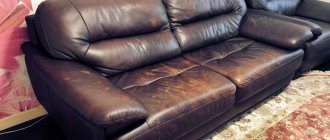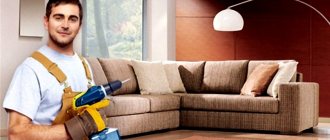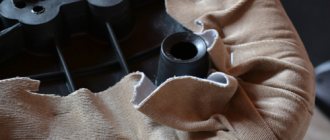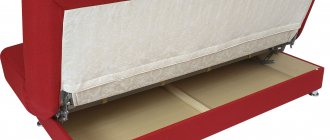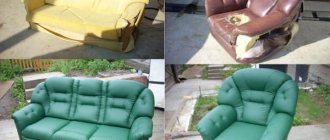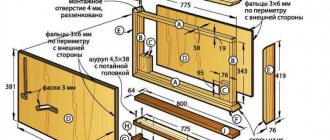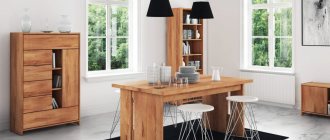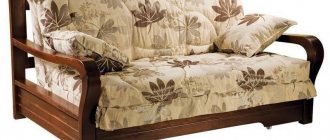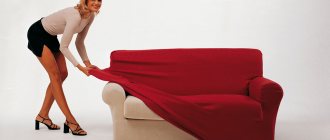Many people have an old sofa at home that is a pity to throw away, because the frame of the sofa is still intact, the springs have not sagged, the locks work, but the appearance is no longer the same due to the shabby upholstery. In this case, you don’t want to order a sofa reupholstery, because the old sofa is not so valuable. To reanimate an old sofa, the best option is to reupholster the sofa yourself.
Benefits of restoration
Many citizens are suspicious of restoring old furniture, although it has a lot of undeniable advantages. These include:
- saving money;
- independent choice of design;
- preserving memories associated with an antique item;
- improvement of weak points of the design to increase ease of use.
Budget savings
The main plus for which many decide to restore the sofa. Updating parts that have exhausted their service life costs much less, and the remaining money can be spent on more pleasant needs.
Antique Preservation
Old, antique things have always been valued. Why throw away a good, sturdy sofa that has a lot of memories attached to it? It’s easier to refresh its appearance and continue to use it for your pleasure. Perhaps in the future, the money saved on buying a sofa will be better used.
Choice of colors
When purchasing new furniture, the problem of choosing the right color scheme that harmoniously fits into the current interior of the room often arises. In case of restoration, it is much easier to buy fabric of the desired color, and this saves not only money, but also time.
Independent selection of material according to quality
Another undoubted advantage is the ability to choose the quality of the material used for restoration. An old sofa can be covered with more expensive fabric, which will significantly increase its appearance. At the same time, the price of a new product made from the same material will be many times higher.
Strengthening weak points
Buying new furniture always carries the danger of unexpected defects or design flaws that reduce the ease of use. All the disadvantages of old furniture are already known and they can always be eliminated by purchasing a couple of extra parts. This way you will update the appearance and strengthen the structure as a whole, with a minimum investment.
How to repair a sofa at home?
If a thing has lost its former attractiveness, you can return it to its original appearance through a number of techniques.
How to update an old sofa:
- Cleaning covers. This option is suitable when it comes to small pieces of furniture. But if desired, even a sofa cover can be subjected to this procedure if the upholstery material is attractive and still well preserved. The method is relevant if you currently cannot purchase a suitable case. The advantages of this way out of the situation include, first of all, financial savings. By cleaning, you get the opportunity to spend only temporary resources with a minimum of cash costs. You will need to purchase suitable laundry detergent and furniture fittings (backing material and staples). If you choose this method, you should be aware that the fabric used for upholstery of interior items is not suitable for washing, and therefore there is a very high probability that after completion of the procedure it will decrease in size or unravel.
Design
The advantages of restoration are more or less clear, now it’s time to understand the design of the sofa. This will allow you to determine the importance of a particular part, the amount of work to be done and the approximate cost of repair.
Frame
The basis of the structure, which bears the heaviest loads. Try not to purchase products made from chipboard. They are too fragile and quickly become unusable. A good frame is expensive, but the service life of such furniture is much longer.
Spring block base
An important detail responsible for ease of fit. If it is damaged or fails, the structure becomes inconvenient to use, and its working life is exhausted faster than usual.
Spring block
The spring block base provides the seat with elasticity and comfort. If it fails, the sofa will begin to make creaking sounds, wear out faster and spoil the upholstery from the inside. You shouldn't let your furniture get into this state. Timely repairs will solve many problems and contribute to further savings.
Felt or thick fabric
Felt is a natural material used in the assembly of sofas. Felt, or thick fabric, is used in old-style sofas as a protective layer and there are usually no problems with replacing them.
Polyurethane foam
Cheap and durable filler, widely used in the furniture industry. Polyurethane foam comes in two types:
- block;
- cast.
See also
Causes of air conditioner malfunctions and how to fix them yourself
Note! To fill sofas, polyurethane foam is used, the density of which ranges from 30 to 40 kilograms per square meter. Fillings with a density below 30 kilograms are used only for the manufacture of decorative pillows.
Sintepon.
Synthetic filler made from non-woven fabric. It is used in budget designs due to its low cost.
Most often, it is not used as a basis for filling upholstery, but is combined with other, higher quality materials.
Upholstery fabric
The upholstery fabric is responsible for the decorative properties of the sofa and protects it from external influences. The higher quality and more expensive the upholstery, the longer the furniture retains its fresh, presentable appearance. There are a large number of materials for these purposes - you will always have plenty to choose the best option from.
Reupholstering or replacing upholstery of upholstered furniture
Reupholstering can also be quite a task, but it's definitely worth it, especially if you don't have any special plans for the weekend. Next, you will learn how to properly reupholster an old sofa or chair with your own hands.
Stage 1. Removing old upholstery
- You may feel like you know this piece of furniture by heart. But still, before removing the upholstery, take pictures of it inside, outside, front and back, taking close-ups of especially difficult areas near the armrests, etc.
- Carefully remove the old upholstery, being careful not to damage it or the furniture itself. You may need an anti-staple gun, a screwdriver and other tools for this. It is recommended to remove the fabric in the following order:
- From the lower base (turning the sofa onto its back or upside down);
- From the outside of the backrest and armrests;
- From the inside of the back and armrests;
- From the seat.
You will use the old upholstery as a template. Before applying it to new fabric, we recommend ironing it.
Stage 2. Sewing new upholstery and reupholstering upholstered furniture
- Use your photos and old upholstery as a guide. Start reupholstering the furniture from the bottom base, then work on the armrests, backrest and seat in that order.
2. Cut the fabric according to the finished template, taking into account the following:
- On the edges that will be sewn with thread, leave an additional 10-15 mm of fabric;
- At the edges that will be stapled, add about 50mm, which will be used to pull the upholstery over the sofa.
3. Sew sections of fabric where necessary and stretch it over the bottom, securing it with a stapler along the edges.
4. Next comes the inner side of the armrests.
5. Next to it is the outer part of the armrests.
Notice how the master did without seams and secured the outer upholstery of the armrests with a hammer
The photo below shows an alternative option for restoring the armrests. The master secured them with a stapler, and then covered the staples with a beautiful braid.
- Let's return to our example. After the armrests came the turn of the backrest. A rope sewn around the perimeter gives it an interesting and expressive shape.
This technique can also be used to add expressiveness to the armrests, which is what was done during the restoration of this chair.
- The outer part of the backrest is secured in the same way as the outer upholstery of the armrests. Additionally, the sofa was decorated with buttons and new legs. In the next photo you can compare the sofa before and after repair and reupholstery.
Kinds
The complexity of restoring a sofa and its final cost largely depend on the type of furniture. Some models can be repaired quickly and without problems, while others will require a lot of resources. Let's figure out what types of sofas exist and what to expect if they break down.
Accessories
Regardless of the design of the sofa, the fittings are considered as a separate item. It consists of auxiliary structural elements, which also wear out over time. Sofa accessories include:
- legs;
- wheels.
They come in different sizes and shapes, and strength often depends on the material of manufacture.
Book
Comfortable and practical sofa models that have been popular since Soviet times. Pros of a sofa book:
- variability. Can be used as a sofa and as a bed;
- when assembled it has compact dimensions;
- has additional sections in which you can store bed linen or things.
Minuses:
- It cannot be placed close to the wall, since in this position it cannot be disassembled.
Eurobook
The sofa from the Eurobook series is considered a leader in terms of structural strength. This effect is achieved due to the simplicity of the design, which reduces the possibility of breakdown to a minimum. Advantages:
- easy to disassemble and assemble;
- large selection of sizes and shapes;
- no need to move away from the wall if there is a need for additional bed space.
Flaws:
- the price is higher than that of a book sofa.
Eurobook "Tick-tock"
The difference from the basic model is the mechanism for converting the sofa into a bed. You won't have to pull out the folding module, scratching the floor covering. The transformation process is carried out by weight, which makes the procedure silent and practical.
The only drawback of this design is the need to remove special pillows during transformation, which come with the sofa.
Accordion
A compact and practical sofa, which got its name because of the mechanism of transformation into a bed, reminiscent of the bellows of an accordion. Advantages of the model:
- small dimensions when folded;
- high orthopedic qualities;
- ease of use.
Flaws:
- There are many complex parts in the mechanism, some of which rub against each other during transformation. This significantly increases wear on the upholstery and the structure itself.
Click-clack
A type of sofa-book, equipped with a modified disassembly mechanism. The model has three working positions:
- sitting position;
- lying position;
- "chaise lounge" position.
The name comes from the characteristic sounds made by the furniture during transformation.
Dolphin
Universal furniture with an elongated corner part. It is used in the interior of spacious living rooms, but if necessary, it fits harmoniously into small rooms. Advantages of the model:
- the sleeping place is level, without changes;
- easy to disassemble and assemble.
Flaws:
- If low-quality, cheap materials are used during the assembly process, the product will quickly become unusable.
Materials
When buying a sofa, first of all, pay attention to the upholstery and filling. These materials are most subject to mechanical stress, which reduces the shelf life of the product.
Polyurethane foam
A material with high strength and low price. Not used as a main filler. In most modifications of sofas, both old and new, polyurethane foam acts as a gasket, combined with other fillers.
Holofiber
Synthetic material with the following distinctive features:
- Easily restores its original shape due to the porous structure of the substance.
- No harmful chemicals are used in the production process, making the material classified as environmentally friendly.
- Lasting.
- Long lasting.
Flaws:
- It requires proper care, otherwise it quickly loses its properties, becoming unusable.
Sintepon
A common synthetic material used, among other things, in the production of furniture. Among the advantages of synthetic winterizer are:
- cheap;
- when deformed, quickly returns to its basic shape;
- The fibers of the material are strong and, under strong impact, do not tear, but stretch.
See also
How to properly glue a foam plastic ceiling plinth with your own hands
Minuses:
- may have a negative impact on health if manufactured using the adhesive method;
- When rubbed, it creates a static charge of electricity.
Vatnik
Used as flooring, combined with other fillers. Material Features:
- soft, pleasant to the touch;
- does not harm health;
- cheap;
- allows air to pass through well.
Flaws:
- not suitable as the main filler, since the fabric fibers have low elasticity. Because of this, a product made from quilted jacket does not restore its original shape well, which affects its appearance.
Periotec
Non-woven material of increased comfort, used as a filler in:
- mattresses;
- furniture;
- pillows;
- blankets
Pros:
- quickly recovers even with repeated deformation of the canvas;
- makes the furniture more comfortable;
- hypoallergenic;
- allows air to pass through well.
Flock
Textiles that have undergone chemical treatment, the front side of which is covered with a small pile. Many people confuse it with velor. Advantages:
- dense;
- soft;
- increased wear resistance;
- allows air to pass freely.
Negative qualities:
- substances that contain alcohol have a destructive effect on flock;
- highly electrified.
Velours
A budget alternative to velvet, used in the production of room furniture. It has a pleasant, soft fiber structure. The material is dense, which increases its wear resistance.
Jacquard
Expensive material made from various fabrics. Its main feature is considered to be its exceptional appearance and labor-intensive manufacturing process. A product covered with jacquard will decorate any home.
Chenille
A type of jacquard fabric that differs from regular fabric in the complexity of the thread weaving. Used for upholstery:
- chairs;
- armchairs;
- sofas
Tapestry
Fabric for upholstery, the threads of which are intertwined in a special way, creating a certain pattern on the surface of the material. Among the advantages are:
- beauty;
- durability;
- wide selection of colors and patterns.
How to restore a sofa with your own hands?
Even the most high-quality furniture during intensive use breaks down or loses its former attractiveness. There is no need to immediately get rid of it after making purchases. There are a huge number of methods using which you can update interior items. You don't even need a restoration specialist for this. It is completely possible to repair a sofa with your own hands. Below are ways that will help give things an updated look.
Required materials and tools
In a situation where you decide to restore the sofa yourself, do not forget to prepare properly. For repair you will need:
- electric jigsaw;
- construction adhesive;
- stapler for furniture;
- screwdriver;
- pliers;
- upholstery material and filler.
Tapestry, velor or suede
Professionals who have been involved in furniture restoration for a long time advise choosing one of the following materials for upholstery:
- tapestry;
- suede;
- velours.
They have the best characteristics in their price segment, and everyone will find an option to suit their pocket.
Simple plain fabric
Used to create a fastening cover. Any fabric you can afford will do.
Special furniture foam rubber
Used as a filler for a sofa. It is considered the best option in terms of price and quality ratio. If you have broad financial capabilities, you can purchase other, more expensive material.
Thick fabric
Thick fabric, such as carpet, is used to protect the box spring. You will need a large piece of fabric, since protection is required on both sides.
Note! Try to buy high-quality materials, otherwise another restoration will soon be required.
Construction adhesive
Glue from any manufacturer will do. During the restoration process, no more than one tube of the substance will be useful, so there is no need to make large supplies. Glue is used to carefully fix the material.
Furniture stapler
A furniture stapler is used to secure the upholstery of a sofa. The stapler must come with at least one clip of staples.
If you don’t have a stapler, you’ll have to buy it in a store or ask your neighbors for the tool.
Durable nylon thread
A sofa cover made from the upholstery material of your choice will be sewn with nylon thread. The thread should come with a strong needle.
Spanner, pliers and screwdriver
They will be useful when working with the mechanical parts of the sofa, in case of replacement or adjustment. Any set of these tools sold at a hardware store will do.
Jigsaw
An indispensable thing when working with wooden parts of the sofa. If you need to saw off, trim or correct something, you won’t find a better tool.
It is advisable to purchase it for permanent use, as it will come in handy many times in the future.
Frame repair
When restoring furniture, it is important to restore the integrity of the frame. First you need to carefully examine it to find any existing damage. Then the broken parts are removed and new elements are made from them. You can make the parts yourself by cutting them from dry wood. But it is important to fit them in size to the nearest millimeter. If you are not confident in your abilities, then it is better to entrust the production of elements to specialists in a carpentry workshop.
Finished parts are attached to the frame with self-tapping screws or nails. Tenon-groove joints are additionally lubricated with construction adhesive.
Instructions
After all the materials for restoration have been purchased and the tools have been prepared, it’s time to move on to the repair itself. This process is not complicated, you just need to be careful and consistently follow all the steps described in the instructions.
Checking and repairing upholstered furniture frames
The first step in restoring a sofa is to check all its components for integrity and functionality. If any boards are rotten or cracked, try to replace them.
This approach will allow you to properly repair old furniture, after which it will serve for many more years.
Dismantling and inspection
After checking the frame, the process of dismantling individual structural elements begins, such as:
- armrests;
- sofa backs;
- upholstery;
- filler;
- springs
See also
How to properly lay tiles on the floor with your own hands, installation methods and technology
Side armrests
In most models, the fastener is located on the inside, and to get to it you will need:
- hex socket wrench;
- pliers.
If these tools are available, there will be no difficulties with dismantling.
Seats and backrests
The seats and backrests are fixed using special fasteners to the lower frame of the sofa. The tools you prepared before starting the repair of the product will help you cope with the fasteners.
Old upholstery, staples
The old upholstery is attached to the wooden parts of the sofa using special staples. They must be carefully removed, after which removing the upholstery will not be difficult.
Old filler
Once the upholstery is removed, access to the sofa filling will open. It is advisable to immediately replace it with a new one, but if it is in acceptable condition, you can leave the old filling.
Springs, checking their condition
Once the filler is removed, we move on to evaluating the springs. If the inspection result shows a satisfactory condition, it is enough to clean and coat the old parts with lubricant.
If some springs are damaged, be sure to replace them with new ones.
Checking the condition of the chipboard
Often it is the chipboard sheets that become unusable first. Replace damaged parts of the structure or leave the old ones if their condition allows reuse.
Repair and replacement of old elements
After all the components of the sofa have been dismantled, you can proceed to repair and replacement of old parts. Subject to inspection:
- base for a spring block;
- spring block;
- mechanisms responsible for disassembling the sofa;
- slats.
Spring block base
The base for the spring block is completely changed if any defects or malfunctions are detected. Fastening to the block is carried out using a stapler. If you couldn’t find a stapler, take:
- thin cloves;
- steel wire.
We make brackets from them and attach the springs.
Spring block
To repair a spring block, you must:
- replace faulty springs;
- cover each side of the block with thick fabric, which is attached to the part using a nylon thread.
Note! The edges of the fabric are folded inward.
Case and cover
Fastening the cover and covering the frame with upholstery is carried out using construction glue and a stapler. Don't forget to return the old filler or replace it with a new one.
Mechanism repair
Repairing sofa mechanisms has its own nuances, depending on which operating principle is used:
- folding;
- roll-out
In roll-out ones, the roller most often fails, and in folding ones, the springs fail, which over time lose their shape and burst.
Lamels
Reasons for lamella failure:
- poor quality of material;
- high load on a separate section.
Damaged strips are bent until they completely come out of the fixing grooves, after which a new part is installed in their place.
What elements need to be replaced?
Before you begin restoring a product, you should determine which parts need updating. The wear process is accompanied by disturbances in the design and appearance of the product. Sometimes it is enough to update the upholstery, but most often all structural elements need repair and restoration. It's time to restore the sofa if:
- The fabric or leather covering has become dull, abrasions and tears have appeared. The filler hidden under the upholstery has become less elastic, and sagging spots have formed on the seat - in this case, replacement of materials will be required.
- The structure became loose and the integrity of the internal fastenings was damaged. A loose frame must be repaired, but if the sheathing boards are cracked or broken, they will need to be replaced.
- It has become difficult to unfold and fold the sofa, it requires effort, and the transformation mechanism gets stuck. Problems may be associated with deformation of the fittings or weakening of the return springs - they will need to be replaced.
It is advisable to use components from the same manufacturer that were originally installed, otherwise incomplete fit of the parts and rapid failure of the mechanism are possible.
Decoration
Decorating the sofa is done using:
- creating beautiful pillows;
- carriage screed;
- figured solid wood.
Beautiful pillows
Pillows are made independently, from leftover material, or purchased in a store. It all depends on your financial capabilities.
Carriage tie
The back of the sofa is decorated with a carriage tie. To do this, small circles are cut out of the foam rubber during stuffing, after which buttons will be sewn in their place. This will help prevent the material from curling. Afterwards the frame is covered with fabric and decorative elements are sewn on.
Figured wood
Wooden armrests can be decorated by gluing solid wood onto them. Such a sofa will look much more beautiful and will last longer than usual.
Fighting nasty odors from upholstered furniture
The fight against the persistent smell of old upholstered furniture begins with ventilation in a good draft or during a strong wind in the yard. The candidacy is to vacuum for a long time.
Then wipe all hard parts with potassium permanganate or water with a few drops of chlorine-based bleach. Ventilate again later.
If you decide to leave the upholstery, then it is much more difficult to remove the smell. First, stains are removed and general cleaning is done with a soapy substance and dishwashing detergent or hot soda ash. Before you start repairing an old sofa with your own hands, remove the hopelessly damaged upholstery.
From time to time, virtually brand new upholstery is ruined by children's feces or urine.
The best method of dealing with such odors is to clean everything and cover the sofa at night (that is, in the dark)
a damp sheet soaked in a vinegar solution, then cover it with baking soda and vacuum it. It is also recommended to place a cup of salt and dry mint or ground coffee under the product.
Features of choice
When choosing fabric for lining and padding, it is worth considering some nuances, which we will discuss below.
Upholstery fabrics
When choosing your upholstery fabric, keep the following details in mind:
- the fabric should be easy to clean from dirt;
- the fabric should look attractive;
- Resistant to exposure to ultraviolet radiation and moisture.
Filler
When constantly using furniture for its intended purpose, choose:
- latex;
- durafil;
- spring block;
- holofiber.
Spring block repair
Replacing the spring unit is required in cases where there are serious damages that cannot be repaired. If several springs are damaged, they can be restored. They are easily straightened with pliers. They can also be completely removed and replaced with new springs, connecting them with other wires.
If a snake-shaped block is installed in the sofa, then severely bent or broken parts are replaced with a new snake, which you can make yourself. To do this, a thick grosgrain ribbon is wound around a thick block of wood, and one end is nailed to the frame. Then the wire is pulled in the opposite direction, creating a semblance of waves.
